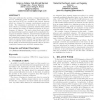Free Online Productivity Tools
i2Speak
i2Symbol
i2OCR
iTex2Img
iWeb2Print
iWeb2Shot
i2Type
iPdf2Split
iPdf2Merge
i2Bopomofo
i2Arabic
i2Style
i2Image
i2PDF
iLatex2Rtf
Sci2ools
MM
2015
ACM
2015
ACM
Learned vs. Hand-Crafted Features for Pedestrian Gender Recognition
This paper addresses the problem of image features selection for pedestrian gender recognition. Hand-crafted features (such as HOG) are compared with learned features which are obtained by training convolutional neural networks. The comparison is performed on the recently created collection of versatile pedestrian datasets which allows us to evaluate the impact of dataset properties on the performance of features. The study shows that hand-crafted and learned features perform equally well on small-sized homogeneous datasets. However, learned features significantly outperform hand-crafted ones in the case of heterogeneous and unfamiliar (unseen) datasets. Our best model which is based on learned features obtains 79% average recognition rate on completely unseen datasets. We also show that a relatively small convolutional neural network is able to produce competitive features even with little training data. Categories and Subject Descriptors I.4.7 [Feature Measurement]: Feature represe...
MM 2015 | Multimedia |
| Added | 14 Apr 2016 |
| Updated | 14 Apr 2016 |
| Type | Journal |
| Year | 2015 |
| Where | MM |
| Authors | Grigory Antipov, Sid-Ahmed Berrani, Natacha Ruchaud, Jean-Luc Dugelay |
Comments (0)

